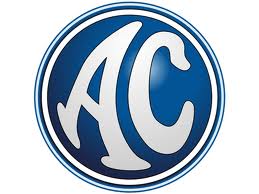A brief history of
AC
Introduction
The car manufacturer AC has made an important impact on the automotive world. In this article we will give a brief but detailed history of the AC marque.
We will look at the origins of AC looking at who, why, where and when AC was founded. We'll look at the design of the iconic AC logo and what are some the more significant AC models.
We'll take a glance at what racing history the AC has and who some of the most important people have been in the history of AC over the years.
Who, where, when and why was
AC founded?
The car manufacturer AC has a rich history that dates back to its founding in 1901. The company was established by John Weller and John Portwine as Auto Carriers Ltd. in the town of West Norwood, London, England. Originally, AC focused on producing three-wheeled delivery vehicles, commonly known as "Auto Carriers," hence the name of the company. These three-wheelers gained popularity for their practicality and efficiency in urban settings.
However, it wasn't until the 1920s that AC transitioned into producing passenger cars. With the introduction of the four-wheeled AC Sociable in 1921, the company expanded its offerings to cater to a broader market. Throughout the following decades, AC continued to produce a range of models, including sports cars and luxury vehicles.
In terms of significance, AC is best known for its iconic sports car, the AC Cobra. In the 1960s, AC collaborated with Carroll Shelby, an American racing driver and entrepreneur, to create a high-performance sports car that combined a lightweight AC chassis with a powerful Ford V8 engine. The result was the AC Cobra, which quickly gained fame for its exceptional speed and performance. The AC Cobra became a symbol of automotive excellence and achieved numerous victories on the racetrack, solidifying AC's reputation as a manufacturer of high-performance vehicles.
Today, AC continues to produce sports cars that pay homage to its heritage while incorporating modern technology and design. The company's commitment to performance, craftsmanship, and innovation ensures that AC remains a respected name in the automotive industry.
How did the
AC logo originate?

How did the AC logo originate?
The AC logo has evolved over the years to represent the brand's identity and values. The earliest iterations of the logo featured the company name "AC" in a simple, elegant font. As the company transitioned into producing sports cars, the logo underwent refinements to reflect the brand's emphasis on performance and speed.
In the 1960s, with the introduction of the AC Cobra, the logo underwent a significant transformation. The iconic AC Cobra logo featured a coiled snake, representing power and agility, along with the AC lettering. This logo became synonymous with the high-performance nature of the AC Cobra and became instantly recognizable among automotive enthusiasts.
Over the years, AC has refined its logo to adapt to changing design trends while maintaining its core elements. The current AC logo features a sleek, modern font with the AC initials in an emblematic style. The logo embodies the brand's heritage and commitment to performance, capturing the essence of AC's sports car legacy.
What are some of the significant
AC models?
AC is renowned for producing a range of significant models throughout its history, with a particular focus on higher performance vehicles. These models have showcased the brand's commitment to engineering excellence and have left a lasting impact on the automotive industry.
In the early years, AC produced three-wheeled delivery vehicles, but it wasn't until the 1920s that they ventured into producing passenger cars. One of the notable models from this era is the AC Six, introduced in 1922. This luxury vehicle featured a six-cylinder engine and elegant styling, making it a popular choice among discerning customers.
As the automotive landscape evolved, AC embraced the sports car segment with the launch of the AC Ace in 1953. The AC Ace was a lightweight two-seater roadster with a responsive chassis and a variety of engine options. Its sleek design and thrilling performance made it a favorite among driving enthusiasts.
In the 1960s, AC collaborated with Carroll Shelby to create the legendary AC Cobra. The Cobra was a game-changer, combining the lightweight AC Ace chassis with a powerful Ford V8 engine. It became an instant icon, known for its blistering speed and raw power. The AC Cobra remains one of the most revered and sought-after sports cars of all time.
Continuing their pursuit of high-performance vehicles, AC introduced the AC 428 in the late 1960s. This grand tourer combined elegant styling with a potent V8 engine, offering a perfect blend of comfort and performance. With its luxurious interior and impressive power, the AC 428 was a popular choice for discerning drivers.
In recent years, AC has embraced the electric revolution with the AC Cobra Series 4-electric. This model combines the classic design of the AC Cobra with modern electric powertrain technology, delivering exhilarating performance and zero-emission driving. The AC Cobra Series 4-electric demonstrates the brand's ability to adapt to changing market demands while preserving its heritage.
Throughout its history, AC has consistently pushed the boundaries of performance and engineering. From the AC Six to the iconic AC Cobra and the modern AC Cobra Series 4-electric, each model represents a testament to the brand's dedication to creating exceptional vehicles that thrill drivers and capture the imagination of automotive enthusiasts.

One of AC's Most Iconic Models
Who are some of the most important people in
AC's History
Behind the success of AC, there have been several significant individuals who have played crucial roles in shaping the brand and its legacy. These individuals have contributed their expertise, passion, and vision to the development of AC's iconic models and have left a lasting impact on the company.
One of the notable figures in AC's history is John Weller, the chief engineer responsible for the design and development of the AC Ace and AC Cobra. Weller's engineering prowess and attention to detail were instrumental in creating the lightweight chassis and refined handling characteristics that became synonymous with AC sports cars. His collaboration with Carroll Shelby resulted in the creation of the legendary AC Cobra, solidifying his status as a key figure in AC's history.
Another significant person in AC's story is Derek Hurlock, who took over the company's management in the 1960s. Hurlock played a vital role in the brand's transition from producing traditional sports cars to embracing more modern and powerful engines. Under his leadership, AC introduced the AC 428, a grand tourer that combined performance and luxury. Hurlock's business acumen and strategic decisions helped AC navigate the changing automotive landscape and ensure the brand's continued relevance.
In more recent times, Alan Lubinsky has been a notable figure in AC's history. As the Chairman of AC Cars Ltd., Lubinsky has been instrumental in steering the brand's direction and overseeing the development of new models, including the AC Cobra Series 4-electric. His leadership and forward-thinking approach have enabled AC to embrace electric powertrains while preserving the heritage and spirit of the iconic AC Cobra.
Additionally, the skilled craftsmen and technicians who have worked at AC throughout the years deserve recognition for their dedication to precision and craftsmanship. From the expert engine builders to the skilled bodywork specialists, these individuals have contributed to the exceptional quality and attention to detail that define AC vehicles.
Each of these individuals, along with countless others who have been part of the AC journey, have played a vital role in establishing AC as a respected manufacturer of high-performance sports cars. Their expertise, passion, and commitment to excellence have shaped the brand's identity and ensured its continued success.

One of the most influential people in the history of AC
AC's Racing History
AC has a rich racing history that spans several decades, with its cars proving their performance and competitiveness on various racetracks around the world. The brand's involvement in motorsports has not only showcased the capabilities of AC vehicles but also contributed to the development and refinement of their engineering and design.
In the early years, AC cars participated in a range of motorsport events, including hill climbs, endurance races, and circuit races. The lightweight and agile nature of AC sports cars made them well-suited for competition. One notable achievement was in the early 1950s when an AC Ace driven by Alan Hess won its class at the Monte Carlo Rally. This victory demonstrated the capabilities of the AC Ace as a versatile and competitive racing machine.
However, it was the collaboration with Carroll Shelby that elevated AC's racing legacy to new heights. The AC Cobra, a result of Shelby's vision and the combination of AC's lightweight chassis and a powerful Ford V8 engine, became a dominant force in motorsports. The AC Cobra achieved tremendous success in various racing series, including the famous Shelby Cobra Daytona Coupe winning the GT class at the 1964 24 Hours of Le Mans, beating even Ferrari. The AC Cobra's raw power, exceptional speed, and handling prowess solidified its reputation as a true racing machine.
AC's racing involvement continued into the modern era, with the brand's vehicles participating in classic car racing events and vintage racing championships. These races not only celebrate the heritage and performance of AC cars but also provide enthusiasts and owners with the opportunity to experience the thrill of competitive racing.
Furthermore, AC's commitment to racing extends beyond their production cars. The company has also been involved in developing specialized racing vehicles and components. AC has collaborated with renowned racing teams and manufacturers to create purpose-built race cars, such as the AC 378 GT Zagato and AC 378 Superblower, which have competed in various GT racing championships.
Today, AC continues to maintain a presence in motorsports through its participation in historic racing events and the support of AC Owners Clubs that organize track days and racing meets for enthusiasts. The brand's racing heritage serves as a testament to the performance capabilities and engineering excellence of AC cars, showcasing their ability to excel on both road and track.
Summary
AC is a car manufacturer with a rich history and a strong reputation in the automotive industry. The brand has been involved in motorsports for several decades, showcasing its vehicles' performance and competitiveness on various racetracks around the world. From its early participation in hill climbs and endurance races to its collaboration with Carroll Shelby, AC has left an indelible mark on the racing scene.
One of AC's most significant contributions to motorsports was the development of the AC Cobra, a powerful and agile sports car that achieved remarkable success in various racing series. The AC Cobra's victories, including the class win at the 24 Hours of Le Mans, solidified its reputation as a true racing machine. AC's commitment to racing extended beyond production cars, as the company also collaborated on specialized racing vehicles and components, further cementing its presence in the racing world.
Today, AC continues to honor its racing heritage by participating in historic racing events and supporting AC Owners Clubs, providing enthusiasts with the opportunity to experience the thrill of driving these iconic vehicles. AC's racing legacy serves as a testament to the brand's performance capabilities and engineering excellence, making it a respected name among racing enthusiasts and automotive aficionados alike.
View AC Car Specifications
More Manufacturer Histories.

























